he UNECE WP.29 regulation R155 and ISO/SAE 21434 standard now require automotive manufacturers and suppliers to implement a Cybersecurity Management System (CSMS) to systematically manage cybersecurity risks across the vehicle lifecycle.
A CSMS is more than a set of technical controls; it’s an organizational framework that integrates policies, processes, roles, and continuous improvement to embed security from concept to end-of-life.
Why a CSMS is Critical
Cyberattacks on vehicles can come from various angles — remote hacking, software vulnerabilities, supply chain compromises — with potentially severe consequences for safety, privacy, and brand reputation. Implementing a CSMS helps your organization:
- Meet regulatory requirements to sell vehicles in global markets
- Systematically identify and mitigate risks throughout development and production
- Ensure traceability and documentation for audits and certifications
- Embed cybersecurity culture and accountability within your teams
- Improve resilience to evolving threats over the vehicle’s lifecycle
Core Components of an Effective CSMS
1. Leadership Commitment and Governance
Cybersecurity must be a strategic priority, driven from the top. Leadership’s role includes:
- Allocating sufficient resources and budget to cybersecurity initiatives.
- Establishing a cybersecurity governance structure that clearly defines roles and responsibilities, including appointing a Chief Information Security Officer (CISO) or equivalent.
- Ensuring cybersecurity objectives align with business goals.
- Facilitating communication between cybersecurity teams, engineering, quality assurance, procurement, and legal functions.
This commitment is essential for fostering a culture of security awareness and accountability across the organization.
2. Comprehensive Cybersecurity Policies and Processes
Developing detailed, living policies is fundamental. These policies should cover:
- Risk Management: Defining risk acceptance criteria, assessment methodologies, and mitigation strategies.
- Secure Development Lifecycle: Incorporating security checkpoints from requirements through testing.
- Incident Response: Clear procedures for detection, reporting, mitigation, and communication during cybersecurity events.
- Supply Chain Security: Requirements for supplier assessments, certifications, and incident handling.
- Data Protection: Handling of sensitive data and compliance with privacy regulations.
Policies must be regularly reviewed, updated, and communicated effectively to all relevant personnel.
3. Secure by Design and System Architecture
Security considerations must be integrated early in system design and development:
- Conduct Threat Analysis and Risk Assessment (TARA) to identify relevant threats, attack paths, and potential vulnerabilities.
- Define security requirements at the system, hardware, software, and communication protocol levels.
- Incorporate security controls such as secure boot, cryptographic protections, secure key management, intrusion detection, and secure communication channels.
- Adopt secure coding standards and conduct static/dynamic security testing.
- Perform penetration testing and vulnerability assessments on components and integrated systems.
By embedding security “by design,” organizations reduce costly redesigns and improve resilience.
4. Threat Analysis and Risk Assessment (TARA)
TARA is the backbone of risk management within a CSMS:
- It involves identifying assets, threats, vulnerabilities, and potential impacts.
- Risk is evaluated based on likelihood and severity.
- Mitigations are prioritized based on risk reduction effectiveness and feasibility.
- Importantly, TARA is not a one-time task — it must be iterative and reflect changes in system architecture, threat landscape, and operational context.
- Tools and methodologies supporting graphical attack trees, control mappings, and automated risk scoring enhance accuracy and traceability.
5. Vulnerability and Patch Management
Vehicle cybersecurity depends on timely identification and mitigation of vulnerabilities:
- Implement a vulnerability disclosure and management program to collect, assess, and remediate flaws from internal testing and external reports.
- Establish secure processes for Over-the-Air (OTA) software updates ensuring authenticity and integrity.
- Monitor emerging vulnerabilities from industry feeds, security advisories, and threat intelligence.
- Coordinate with suppliers and software providers to track and resolve component vulnerabilities promptly.
A responsive vulnerability management process minimizes exposure windows and protects end users.
6. Incident Response and Recovery
Despite best efforts, cyber incidents may still occur. Being prepared minimizes impact:
- Develop a detailed Incident Response Plan (IRP) that defines roles, communication protocols, escalation paths, and recovery procedures.
- Integrate cybersecurity monitoring and anomaly detection systems to enable early detection.
- Conduct regular tabletop exercises and simulations to test readiness.
- Establish clear coordination with legal, PR, regulatory bodies, and suppliers for effective response and disclosure.
7. Supply Chain Security
The automotive supply chain is complex and multi-tiered, often involving software and hardware components from numerous vendors:
- Enforce cybersecurity requirements in supplier contracts and procurement processes.
- Perform security audits and assessments of critical suppliers.
- Monitor compliance with secure development practices and incident reporting.
- Foster collaborative risk management with suppliers to address emerging threats.
Ensuring supply chain integrity reduces the risk of introducing vulnerabilities downstream.
8. Workforce Training and Awareness
Human factors remain a major cybersecurity risk:
- Develop role-based training programs for engineers, quality personnel, managers, and executives.
- Raise awareness about phishing, social engineering, secure development practices, and incident reporting.
- Encourage a culture of vigilance and continuous learning.
Empowered and knowledgeable teams are a critical line of defense.
9. Continuous Monitoring, Auditing, and Improvement
Cybersecurity is dynamic — a static approach is insufficient:
- Regularly audit CSMS effectiveness against regulatory requirements and industry best practices.
- Use security metrics and KPIs to monitor performance.
- Conduct penetration testing and security reviews periodically.
- Maintain feedback loops to incorporate lessons learned into process improvements.
- Stay abreast of evolving threats, standards updates, and technological advances.
Continuous improvement ensures the CSMS remains effective over time.
Certification and Compliance
UNECE WP.29 R155 mandates that automotive manufacturers demonstrate an operational CSMS to maintain market access in many countries. Certification under ISO/SAE 21434 further validates your cybersecurity capabilities. Achieving and maintaining certification requires documented evidence of effective processes and continuous risk management — not just a one-time effort.
By embedding security governance, secure by design principles, continuous risk assessment, and supplier oversight, organizations can build safer vehicles, comply with global regulations, and protect their brand reputation.
The journey to a mature CSMS is ongoing and demands organizational commitment, technical rigor, and adaptability to keep pace with the evolving threat landscape. Those who invest early in building and maintaining their CSMS will be better positioned to navigate regulatory demands and secure the trust of customers.


